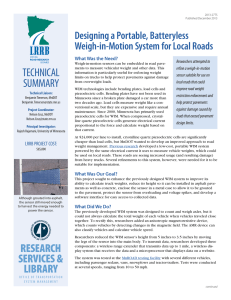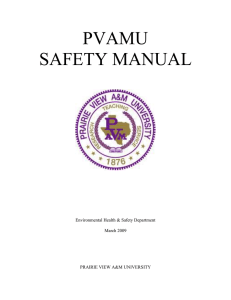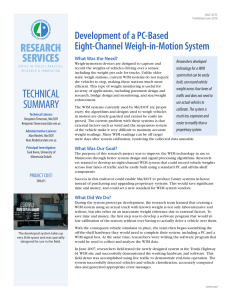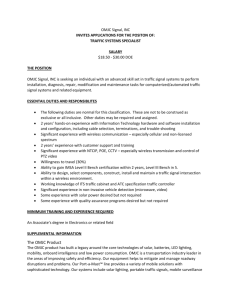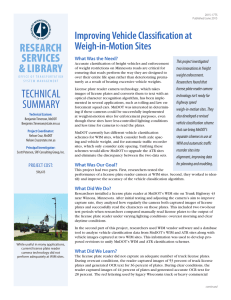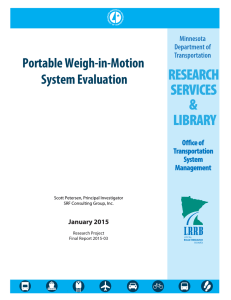RESEARCH SERVICES Development of a Portable Weigh-in-Motion System
advertisement
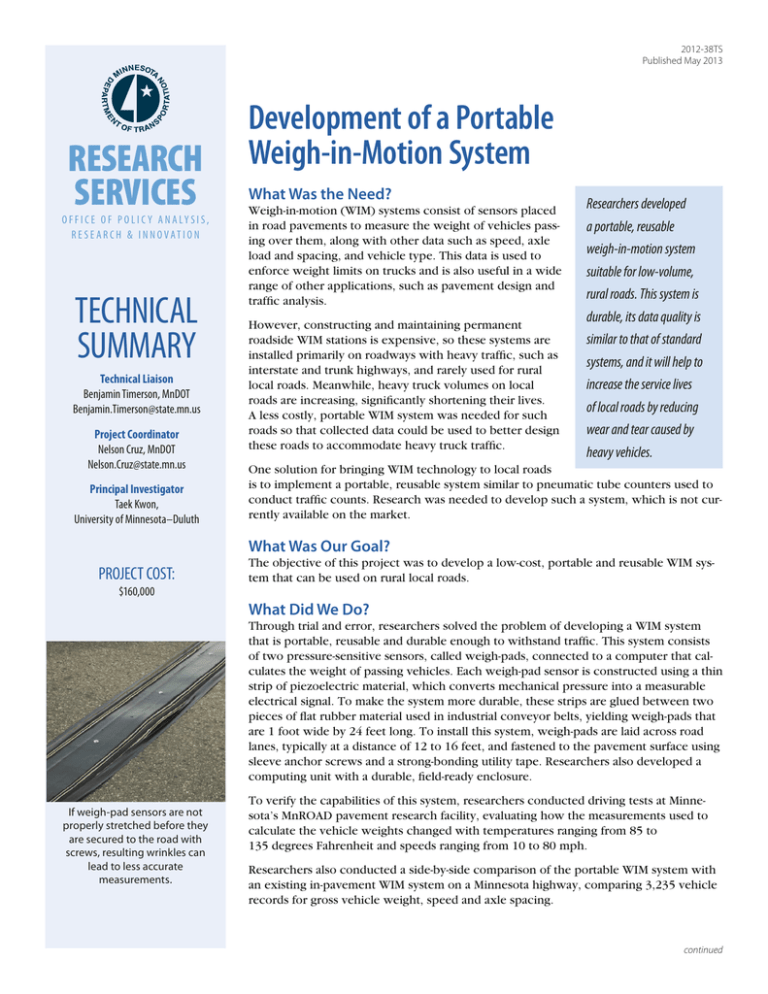
2012-38TS Published May 2013 RESEARCH SERVICES O F F I C E O F P O L I C Y A N A LY S I S , R E SE A R C H & I N N OVAT I O N TECHNICAL SUMMARY Technical Liaison Benjamin Timerson, MnDOT Benjamin.Timerson@state.mn.us Project Coordinator Nelson Cruz, MnDOT Nelson.Cruz@state.mn.us Principal Investigator Taek Kwon, University of Minnesota–Duluth Development of a Portable Weigh-in-Motion System What Was the Need? Weigh-in-motion (WIM) systems consist of sensors placed in road pavements to measure the weight of vehicles passing over them, along with other data such as speed, axle load and spacing, and vehicle type. This data is used to enforce weight limits on trucks and is also useful in a wide range of other applications, such as pavement design and traffic analysis. However, constructing and maintaining permanent roadside WIM stations is expensive, so these systems are installed primarily on roadways with heavy traffic, such as interstate and trunk highways, and rarely used for rural local roads. Meanwhile, heavy truck volumes on local roads are increasing, significantly shortening their lives. A less costly, portable WIM system was needed for such roads so that collected data could be used to better design these roads to accommodate heavy truck traffic. Researchers developed a portable, reusable weigh-in-motion system suitable for low-volume, rural roads. This system is durable, its data quality is similar to that of standard systems, and it will help to increase the service lives of local roads by reducing wear and tear caused by heavy vehicles. One solution for bringing WIM technology to local roads is to implement a portable, reusable system similar to pneumatic tube counters used to conduct traffic counts. Research was needed to develop such a system, which is not currently available on the market. What Was Our Goal? PROJECT COST: $160,000 The objective of this project was to develop a low-cost, portable and reusable WIM system that can be used on rural local roads. What Did We Do? Through trial and error, researchers solved the problem of developing a WIM system that is portable, reusable and durable enough to withstand traffic. This system consists of two pressure-sensitive sensors, called weigh-pads, connected to a computer that calculates the weight of passing vehicles. Each weigh-pad sensor is constructed using a thin strip of piezoelectric material, which converts mechanical pressure into a measurable electrical signal. To make the system more durable, these strips are glued between two pieces of flat rubber material used in industrial conveyor belts, yielding weigh-pads that are 1 foot wide by 24 feet long. To install this system, weigh-pads are laid across road lanes, typically at a distance of 12 to 16 feet, and fastened to the pavement surface using sleeve anchor screws and a strong-bonding utility tape. Researchers also developed a computing unit with a durable, field-ready enclosure. If weigh-pad sensors are not properly stretched before they are secured to the road with screws, resulting wrinkles can lead to less accurate measurements. To verify the capabilities of this system, researchers conducted driving tests at Minnesota’s MnROAD pavement research facility, evaluating how the measurements used to calculate the vehicle weights changed with temperatures ranging from 85 to 135 degrees Fahrenheit and speeds ranging from 10 to 80 mph. Researchers also conducted a side-by-side comparison of the portable WIM system with an existing in-pavement WIM system on a Minnesota highway, comparing 3,235 vehicle records for gross vehicle weight, speed and axle spacing. continued “The technologies developed in this project will allow MnDOT to collect data on local roads using a weigh-in-motion system that can be installed for $30,000 instead of as much as $250,000 for permanent installations.” —Benjamin Timerson, Principal Engineer, Weight Data & Engineering Coordination, MnDOT Office of Transportation Data and Analysis “One of the advantages of the weigh-pad system is that it can be installed without cutting the pavement and weakening its structure, making it safe to use in structurally sensitive areas such as bridge decks.” —Taek Kwon, Professor, University of Minnesota–Duluth Department of Electrical and Computer Engineering Produced by CTC & Associates for: Minnesota Department of Transportation Research Services MS 330, First Floor 395 John Ireland Blvd. St. Paul, MN 55155-1899 (651) 366-3780 www.dot.state.mn.us/research Portable and reusable, weigh-pads can be installed in 15 minutes per lane and removed in 7 minutes per lane using a drill and utility tape. After withstanding 24 hours of traffic on Minnesota Trunk Highway 53, the weigh-pads did not show any signs of damage. What Did We Learn? Results demonstrated that it is possible to build and deploy a reusable, portable WIM system modeled on a pneumatic tube counter. MnROAD testing showed that vehicle weight measurements increased with speed, requiring calibration to offset this effect. However, testing did not confirm an expected correlation between measured vehicle weights and pavement temperatures. This issue had been addressed through use of a custom amplifier built to handle the charge responses of a portable on-pavement system. This amplifier effectively filters out signals generated by pavement heat. The side-by-side comparison of the portable WIM system with an in-pavement system verified that the difference in data quality between the portable on-pavement system and permanent in-pavement system is very small, differing at most by a few percentage points. Further, the data for the weigh-pad system is compatible with the software tool currently used by MnDOT to manage data for standard WIM installations. What’s Next? With funding from the Local Road Research Board, MnDOT will conduct an implementation project to upgrade the system and test it at several sites in Minnesota. Upgrades will include extending the system’s battery life from its current 25 hours to as long as one week, and testing will include optimizing installation time and the process for calibrating the system using test vehicles. Researchers also recommend further work to determine the usable life of weigh-pads; develop a fabrication method that allows reuse of costly piezoelectric strips when weigh-pads require replacement; and refine several other aspects of weigh-pad construction, including the use of vibration damping material to increase accuracy and grooved conveyor belts to provide better fastening and stability. This Technical Summary pertains to Report 2012-38, “Development of a Weigh-Pad-Based Portable Weigh-In-Motion System,” published December 2012. The full report can be accessed at http://www.lrrb.org/PDF/201238.pdf.

